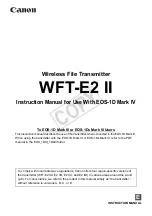
Section E
Driver Supply Regulator (A22)
E.1
Introduction
This section includes a description of the Driver Supply Regula-
tor, and troubleshooting information.
The Driver Supply Regulator assembly includes a printed circuit
board and a heat sink. The printed circuit board is mounted to the
heat sink with spacers. Power MOSFETs in the regulator circuit
are also mounted on the heat sink.
E.2
Location
The Driver Supply Regulator is located in the Driver Compart-
ment and is mounted on the right wall and covered by a clear
safety cover.
E.3
Principles of Operation
The RF drive to the transmitter’s Power Amplifier stage must be
closely controlled for optimum transmitter performance. An RF
drive “Automatic Level Control” loop maintains drive level
automatically by monitoring a sample of the RF drive level to the
Power Amplifier from RF Drive Splitter A15.
RF drive levels to the Power Amplifier stage can change, even if
the Driver output remains the same. If MOSFETs on the Power
Amplifier Modules fail, the load on the Driver will increase,
causing drive level to decrease. The Driver output must then be
increased to compensate for the additional load. The Driver
Supply Regulator also compensates for RF drive changes caused
by AC line voltage variation.
The Driver Supply Regulator controls and regulates two supply
voltages to RF amplifier D8. Increasing the voltages to D8A and
D8B will increase the Driver output. The regulator’s two DC
outputs can each vary from zero to about +110 VDC.
During normal operation D8A voltage will be b40 to
+80 VDC, and section D8B voltage will be zero. If Driver output
begins to decrease, the Driver Supply Regulator will increase the
voltage to D8A until it reaches about +100 to +110 VDC. If more
RF drive is required, the Driver Supply Regulator will increase
the voltage to D8B until it reaches about +100 to +110 VDC. If
still more drive is required, RF amplifier D7 is turned on by the
Driver Encoder/Temp Sense Board A19. The Driver Supply
Regulator will then reduce the voltage to D8A and D8B.
Refer to SECTION V, Maintenance, for adjustment and mainte-
nance procedures.
E.4
Circuit Description
Refer to Simplified Diagram E-1 and to Schematic 839-7855-
004 in the Drawing Package.
E.4.1
+15 Volt Regulator
A 3-terminal integrated circuit voltage regulator, U1, provides
the +15 Volt supply for U2.
E.4.2
CVDC Reference
A CVDC voltage is developed for the regulator
section from the Open Loop Adjust control (through a voltage
follower), or from the output of a differential amplifier with
inputs from the Closed Loop Adjust control and from the RF
drive sample. Switch S1 selects one of these reference voltages.
E.4.2.1
“Open Loop” Reference Voltage
When S1 is in the “OPEN LOOP” position, OPEN LOOP ADJUST
control R2 is the input to a voltage follower (gain = 1), using one
section of operational amplifier U2. The voltage follower output
provides a reference voltage, adjustable from about +1.5 Volts to
+10 Volts, to the Q2 gate circuit. See Figure E-1.
E.4.2.2
“Closed Loop” Reference Voltage
When S1 is in the “CLOSED LOOP” position, the other half of
U2 is used as a differential amplifier. “CLOSED LOOP AD-
JUST” control R12 provides an adjustable voltage to the invert-
ing input of the differential amplifier. The non-inverting input is
a DC voltage derived from a sample of the RF drive to the Power
Amplifier stage and is offset by resistors R9 and R10.
E.4.2.3
RF Drive Sample
The RF drive sample for closed-loop operation is taken from the
RF Drive Splitter A15, and fed to the primary winding on toroidal
RF transformer T1. A network across the primary of T1 broad-
bands the transformer. Capacitors C4 and C5, across the secon-
dary windings, are used to provide a load impedance for the RF
Drive Splitter that is similar to the input impedance of an RF
amplifier module.
The RF drive sample is rectified in a full-wave bridge rectifier
(CR1 through CR4). The output of the bridge rectifier is a DC
voltage sample of the Power Amplifier stage RF drive level. This
DC sample is offset by resistors R10 and R9, filtered by C6 and
fed into U2-3.
The other input to U2-2 is an adjustable DC voltage from Closed
Loop ADJ R12. The output of U2-1 is the difference between the
inputs times the gain of the amplifier. Differential amplifier gain
is set by R11, R12, R13, R14, and R15.
The output of U2-1 is the CVDC voltage and can be
measured at TP4 and monitored on the RF MULTIMETER on
the inside of the Driver Compartment door.
E.4.3
Power MOSFET Operation (A Short Review)
Power MOSFET operation will be reviewed briefly in this para-
graph, for personnel who have not encountered them before. The
n-channel power MOSFETs used in the Driver Supply Regulator
section are effectively “cut off” (not conducting) when their input
voltage is less than the +2 to +4 Volt gate-to-source threshold. As
the input voltage rises above the threshold, the MOSFET will
conduct more heavily. Increasing the gate voltage will increase
888-2297-002
E-1
WARNING: Disconnect primary power prior to servicing.
Содержание DX 25U
Страница 2: ......
Страница 10: ......
Страница 28: ......
Страница 32: ......
Страница 46: ......
Страница 58: ......
Страница 82: ......
Страница 150: ......
Страница 158: ......
Страница 166: ......
Страница 174: ......
Страница 176: ......
Страница 196: ......
Страница 206: ......
Страница 212: ......
Страница 218: ......
Страница 270: ......
















































